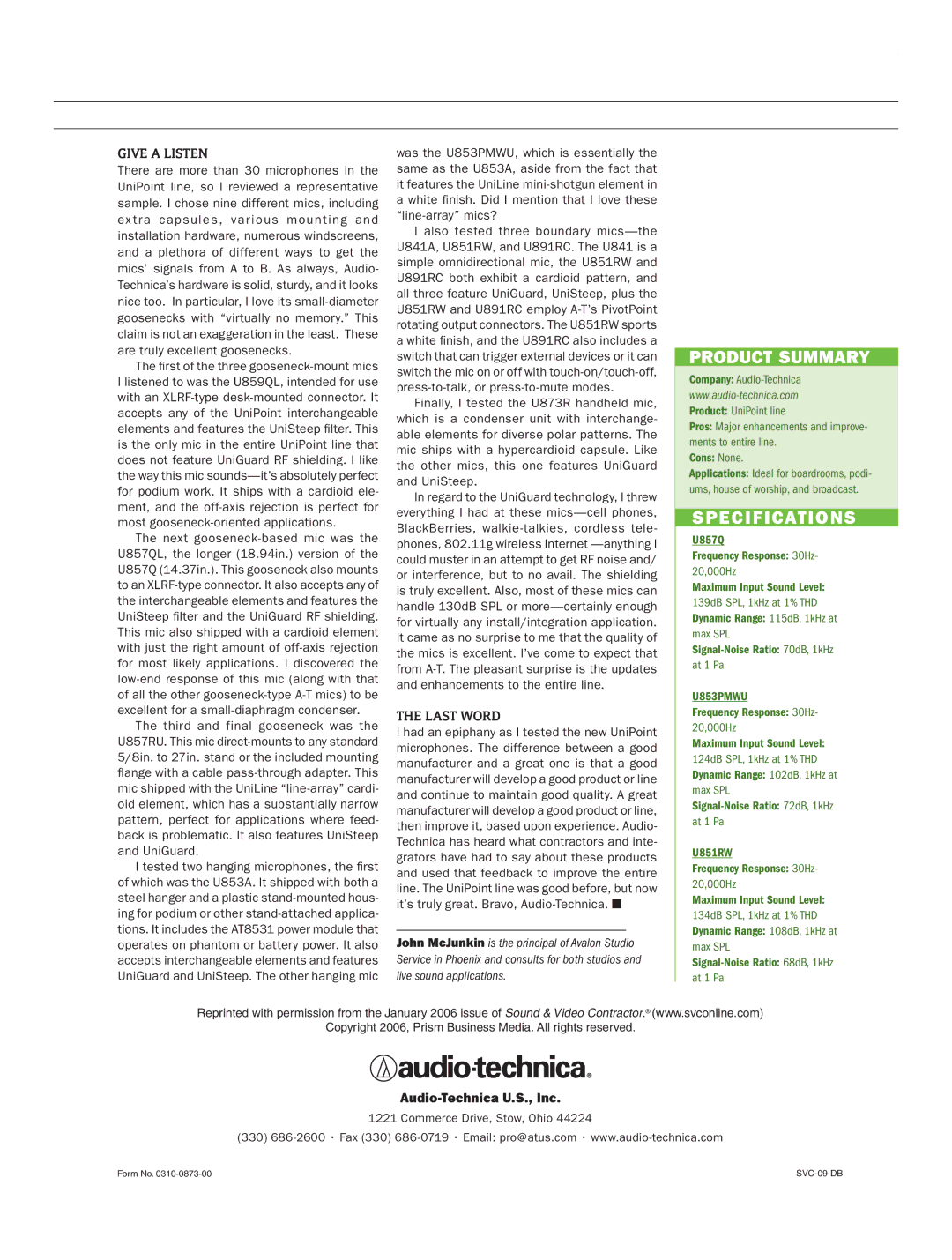GIVE A LISTEN
There are more than 30 microphones in the UniPoint line, so I reviewed a representative sample. I chose nine different mics, including extra capsules, various mounting and installation hardware, numerous windscreens, and a plethora of different ways to get the mics’ signals from A to B. As always, Audio- Technica’s hardware is solid, sturdy, and it looks nice too. In particular, I love its small-diameter goosenecks with “virtually no memory.” This claim is not an exaggeration in the least. These are truly excellent goosenecks.
The fi rst of the three gooseneck-mount mics I listened to was the U859QL, intended for use with an XLRF-type desk-mounted connector. It accepts any of the UniPoint interchangeable elements and features the UniSteep fi lter. This is the only mic in the entire UniPoint line that does not feature UniGuard RF shielding. I like the way this mic sounds—it’s absolutely perfect for podium work. It ships with a cardioid ele- ment, and the off-axis rejection is perfect for most gooseneck-oriented applications.
The next gooseneck-based mic was the U857QL, the longer (18.94in.) version of the U857Q (14.37in.). This gooseneck also mounts to an XLRF-type connector. It also accepts any of the interchangeable elements and features the UniSteep fi lter and the UniGuard RF shielding. This mic also shipped with a cardioid element with just the right amount of off-axis rejection for most likely applications. I discovered the low-end response of this mic (along with that of all the other gooseneck-type A-T mics) to be excellent for a small-diaphragm condenser.
The third and final gooseneck was the U857RU. This mic direct-mounts to any standard 5/8in. to 27in. stand or the included mounting
flange with a cable pass-through adapter. This mic shipped with the UniLine “line-array” cardi- oid element, which has a substantially narrow pattern, perfect for applications where feed- back is problematic. It also features UniSteep and UniGuard.
I tested two hanging microphones, the fi rst of which was the U853A. It shipped with both a steel hanger and a plastic stand-mounted hous- ing for podium or other stand-attached applica- tions. It includes the AT8531 power module that operates on phantom or battery power. It also accepts interchangeable elements and features UniGuard and UniSteep. The other hanging mic
was the U853PMWU, which is essentially the same as the U853A, aside from the fact that it features the UniLine mini-shotgun element in a white fi nish. Did I mention that I love these “line-array” mics?
I also tested three boundary mics—the U841A, U851RW, and U891RC. The U841 is a simple omnidirectional mic, the U851RW and U891RC both exhibit a cardioid pattern, and all three feature UniGuard, UniSteep, plus the U851RW and U891RC employ A-T’s PivotPoint rotating output connectors. The U851RW sports a white fi nish, and the U891RC also includes a switch that can trigger external devices or it can switch the mic on or off with touch-on/touch-off, press-to-talk, or press-to-mute modes.
Finally, I tested the U873R handheld mic, which is a condenser unit with interchange- able elements for diverse polar patterns. The mic ships with a hypercardioid capsule. Like the other mics, this one features UniGuard and UniSteep.
In regard to the UniGuard technology, I threw everything I had at these mics—cell phones, BlackBerries, walkie-talkies, cordless tele- phones, 802.11g wireless Internet —anything I could muster in an attempt to get RF noise and/ or interference, but to no avail. The shielding is truly excellent. Also, most of these mics can handle 130dB SPL or more—certainly enough for virtually any install/integration application. It came as no surprise to me that the quality of the mics is excellent. I’ve come to expect that from A-T. The pleasant surprise is the updates and enhancements to the entire line.
THE LAST WORD
I had an epiphany as I tested the new UniPoint microphones. The difference between a good manufacturer and a great one is that a good manufacturer will develop a good product or line and continue to maintain good quality. A great manufacturer will develop a good product or line, then improve it, based upon experience. Audio- Technica has heard what contractors and inte- grators have had to say about these products and used that feedback to improve the entire line. The UniPoint line was good before, but now it’s truly great. Bravo, Audio-Technica. 
John McJunkin is the principal of Avalon Studio Service in Phoenix and consults for both studios and live sound applications.
PRODUCT SUMMARY
Company: Audio-Technica www.audio-technica.comProduct: UniPoint line
Pros: Major enhancements and improve- ments to entire line.
Cons: None.
Applications: Ideal for boardrooms, podi- ums, house of worship, and broadcast.
SPECIFICATIONS
U857Q
Frequency Response: 30Hz- 20,000Hz
Maximum Input Sound Level: 139dB SPL, 1kHz at 1% THD Dynamic Range: 115dB, 1kHz at max SPL
Signal-Noise Ratio: 70dB, 1kHz at 1 Pa
U853PMWU
Frequency Response: 30Hz- 20,000Hz
Maximum Input Sound Level: 124dB SPL, 1kHz at 1% THD Dynamic Range: 102dB, 1kHz at max SPL
Signal-Noise Ratio: 72dB, 1kHz at 1 Pa
U851RW
Frequency Response: 30Hz- 20,000Hz
Maximum Input Sound Level: 134dB SPL, 1kHz at 1% THD Dynamic Range: 108dB, 1kHz at max SPL
Signal-Noise Ratio: 68dB, 1kHz at 1 Pa
Reprinted with permission from the January 2006 issue of Sound & Video Contractor.® (www.svconline.com)
Copyright 2006, Prism Business Media. All rights reserved.
Audio-Technica U.S., Inc.
1221 Commerce Drive, Stow, Ohio 44224
(330) 686-2600 • Fax (330) 686-0719 • Email: pro@atus.com • www.audio-technica.com

![]()
